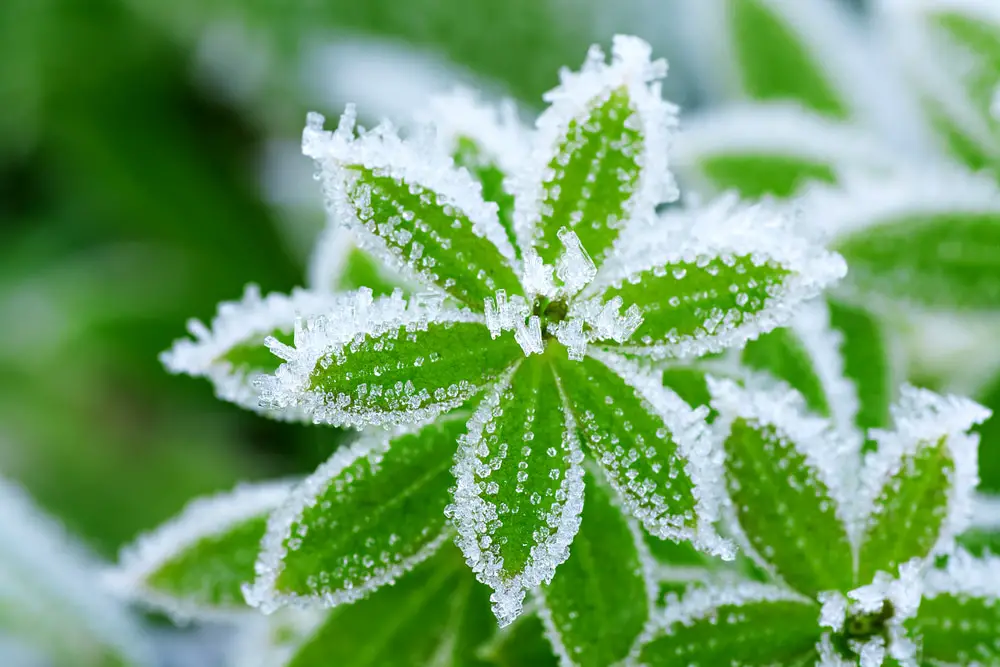Whether or not you need to protect plants from spring or fall frost depends on the type of frost in the forecast, the timing of its arrival, and the type of plants in question.
Seasoned gardeners (no pun intended!) will be familiar with the concept of last and first frost dates. If you’re new to gardening, then these are the average dates of the last frost in the spring – letting us know winter’s still trying to linger – and the first frost in the autumn, signaling winter’s just around the corner.
The frost dates vary based on your specific region and hardiness zone, and even within the same zone, local factors like topography, nearby bodies of water, and buildings can impact when frost occurs. To protect plants from frost, it’s essential to understand your area’s hardiness zone and consider these local conditions.
So, to keep track of the frost potential for your garden, it’s always best to follow your local weather forecasts.
When Should You Protect Plants from Frost?
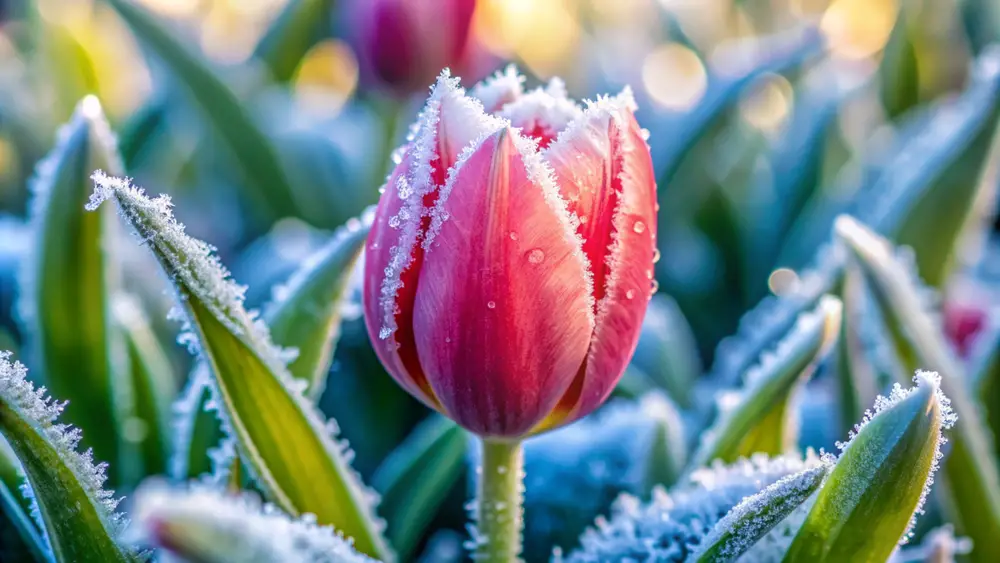
There are two times of year you may need to protect your garden plants from frost:
- Spring: as the growing season is just getting underway
- Early Fall: when the season’s soon wrapping up
Late Spring Frost
In the spring, when the growing season is just starting, you need to protect plants from frost when:
- You’ve planted out young summer-flowering annuals or vegetable transplants and a late frost is in the forecast
- You want to protect newly sprouted seeds
- You have soft fruit (e.g. strawberries, raspberries) with flower buds about to open. Sometimes they open earlier than usual as a result of an unusually warm early spring
Late spring frosts can catch plants – and gardeners – off guard once the season’s new growth gets underway. Young spring foliage is particularly sensitive to late cold snaps because it hasn’t had time to thicken up and fully develop protective outer layers.
Early Fall Frost
In the fall, when the growing season will soon wrap up, you’ll want to protect plants from frost when:
- You have warm-season vegetables that haven’t quite ripened yet
- The forecasted frost is coming unusually early and some newly-planted shrubs or evergreens may not have had time to harden off and transition into their dormant stage for winter
- You want to extend the season for your flowering summer annuals just a little longer
What Is Frost?
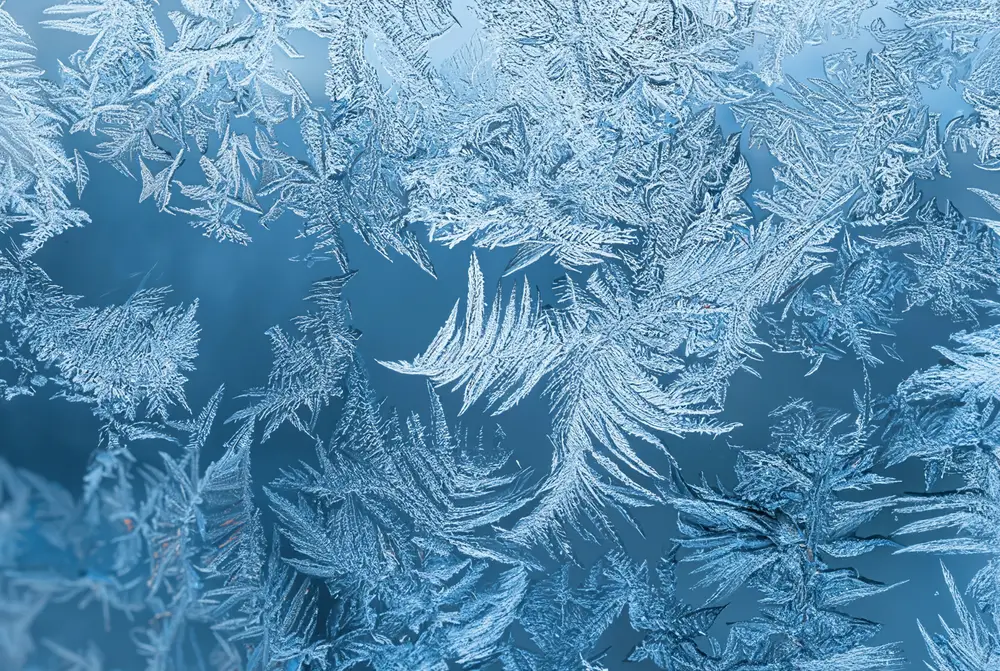
Frost occurs when moisture in the air turns to ice crystals on surfaces – skipping the liquid dew phase – as a result of a sudden drop in air temperature. But not all frosts are the same. Frost comes in more than one form and, for gardeners, it’s important to understand the difference.
Light Frost
A light frost occurs when the night time temperature drops close to or just below freezing, 36 to 28 F (2 to -2 C). This tends to last only a few hours, usually just before dawn. The soil temperature remains above freezing, giving off some heat to protect the lower portions of a plant.
In a light frost, ice crystals form on the outer surfaces of plants. This outer frozen layer actually acts to insulate and protect the inner layers of the plant from the cold.
In these cases, there will be little or no long term damage to most plants, especially hardy perennials, cold tolerant annuals, and cool-season vegetables (see below).
Heavy Frost/Hard Frost
A heavy frost (also known as a hard frost) occurs at temperatures below 28 F (-2 C). A couple of degrees doesn’t seem like much but to a warm-season vegetable plant or summer flowering annual it can mean the difference between survival and calling it quits.
In a hard frost, the colder temperatures last for several hours, increasing the risk of permanent damage to vulnerable plants.
What Factors Contribute To Frost Formation?
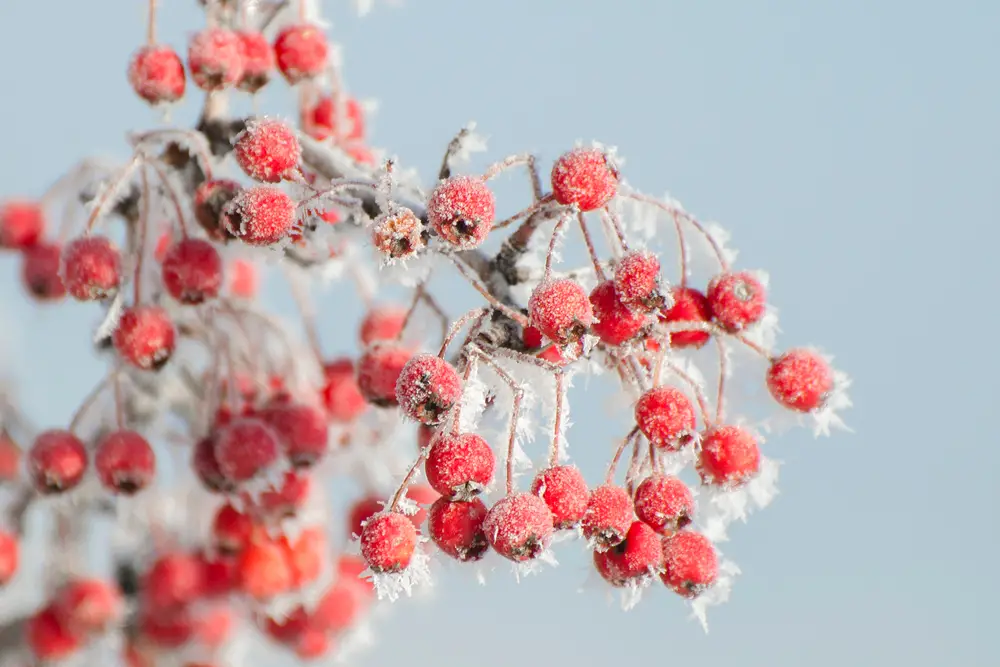
Frost forms due to factors beyond just air temperature, including clear skies, calm air, and topography. Clear nights without cloud cover lead to heat loss, while calm conditions allow cold air to settle around plants. Low-lying areas are prone to frost, but nearby water bodies or buildings can reduce frost risk through gradual heat release.
Let’s dive into the details of the factors that influence frost formation and its duration.
Air Temperature
Air temperature is the first obvious factor that affects the formation of frost. As we discussed, light frost can occur when temperatures reach 36 to 28 F (2 to -2 C). Hard frost occurs at temperatures below 28 F (-2 C).
Clear Skies
Frosts occur on clear nights when there’s no cloud cover to hold in the heat near the earth’s surface. In addition, cold air is denser than warm air and sinks down to the earth’s surface.
Calm Air/Low Wind
When the air is calm, with little or no wind, cold air will settle at ground level around plants, allowing the formation of frost. This is why commercial fruit farmers have equipment that operates like giant fans to keep the air circulating in an orchard which prevents frost from settling on the trees.
Topography
The rise and fall of the landscape affects where and if frost will form. Cold air is denser and heavier than warm air, therefore it sinks down to ground level. So frost is more likely to form in low-lying areas, like valleys or at the bottom of a slope. This tendency of cold air to pool like water can create ‘frost pockets’ where frost can form even in smaller depressions within a larger garden area.
Conversely, plantings on slopes may be less prone to frost because the cold air flows downhill and past them – just like water can – coming to rest in the lower-lying areas instead.
Bodies of water also affect the formation of frost. Water warms up and cools off more slowly than solid ground. As air temperatures cool down, the water stays warmer. This helps maintain the air temperature of the planted areas and helps to reduce the risk of frost.
Buildings
Planting locations up against the side of a house or garden shed will offer better frost protection to plants than open areas in the garden. Against a south-facing wall is even better.
In addition, materials such as brick, cement, and large stones or boulders absorb heat from the sun during the day. They then slowly release that heat (radiant heat) when the sun goes down. So planted areas near brick retaining walls, cement patios, or large boulders benefit from the radiant heat released, which may be sufficient to prevent frost formation (depending on the type of frost that is).
How Does Frost Damage Plants?
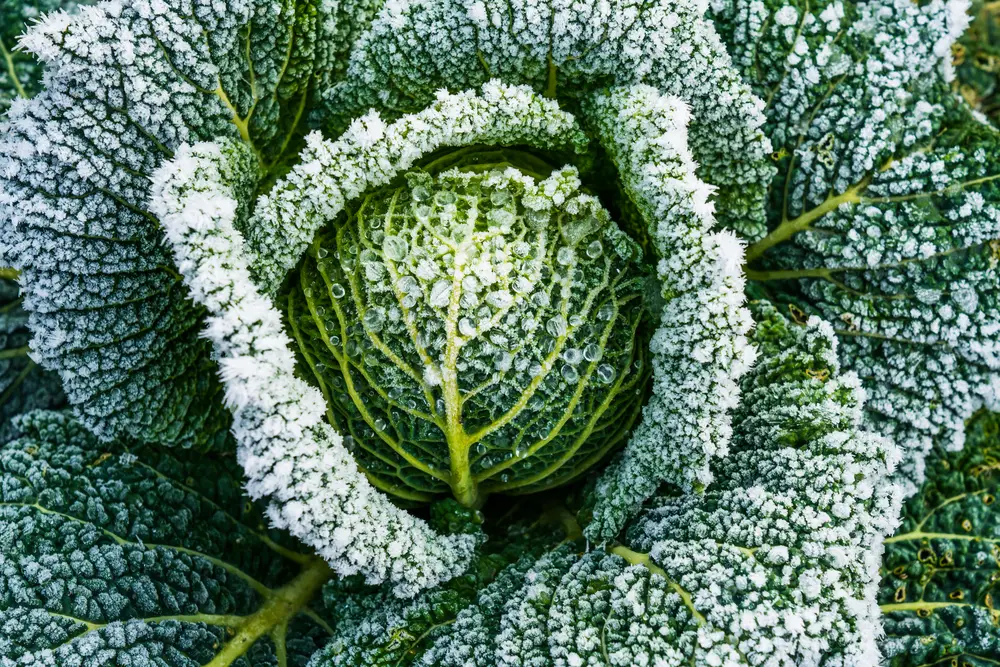
The extent of frost damage depends on:
- The type of plant such as vegetables, tender annuals, hardy perennials, or shrubs
- The nature of the frost – light or heavy
- What stage of development the plant is in when the frost occurs
It’s not just the low air temperature that poses a risk but also the length of time that the temperature stays at or below freezing. A light frost for a few hours one night followed by above-freezing temperatures the following days is less of a concern than several hours of hard frost.
The longer the duration, and the lower the temperature, the greater the risk of frost damage to plants.
What Plants Need Protection From Frost?

When it comes to frost, plants fall into three general categories:
- Frost-sensitive plants: Those that won’t survive even a light frost
- Frost-tolerant plants: Those that can survive a light frost but not a hard frost
- Frost-hardy plants: Trees, shrubs, and perennials that can withstand light or hard frost with minimal, if any, permanent damage when planted in their appropriate hardiness zone
Let’s go into some more detail:
Frost Sensitive Plants
Houseplants
Most houseplants are native to tropical zones where frost is an impossible occurrence. You can grow many of these plants outside for the summer months in more temperate zones. However, you should only take them outside well after (about two weeks after) the risk of frost has passed in late spring. This is when the night time temperature is consistently above about 60 F (15 C). Even then, introduce them gradually to outdoor temperatures. This is a process is “hardening off.”
In the fall, take houseplants back inside before night time temperatures fall below 60 F (15 C). If there is a risk of an unusually early frost, bring them inside, as frost covers won’t provide sufficient protection.
Vegetables
Warm-season vegetables, such as tomatoes and peppers, are sensitive to cold temperatures. These plants need protection from early fall frosts so that the crop can finish ripening.
In the spring, vegetable transplants or young seedlings are more susceptible to frost damage because of their young and tender greenery. Cool season vegetables are more tolerant to late spring light frosts.
Flowering Annuals
True annuals are plants that grow from seed, flower, set seed, and die all in one growing season; they do not overwinter. Some plants that are botanically perennials (regrow every spring) in their appropriate hardiness zone are grown as annuals in zones where it gets too cold for them to survive. We’ll include these in our discussion of frost risk for annuals.
Annuals flower all summer until the first frost of the fall brings them to an end. Providing these plants with frost protective coverings isn’t really worth the effort unless you really want to keep them flowering as long as you can before late fall freezing temperatures arrive.
Young annuals planted out in the spring are at risk of damage from late spring frosts. Garden centers and big box stores are notorious for tempting us with summer flowering annual transplants and petunia hanging baskets well before it’s safe to put them out for the season. Petunias are especially frost-sensitive and can’t tolerate temperatures below 40 degrees F (4 C), so even a light frost will kill them.
So, in the spring prepare to provide frost protection to your newly-planted annuals, or bring hanging baskets inside overnight, if you’ve put them out before the risk of frost has passed.
Frost Tolerant Plants
Pansies and Violas
Pansies and violas are an exception to the rule of annuals being frost sensitive. They can withstand a light frost. In fact, they prefer cooler growing temperatures and are winter hardy to USDA hardiness zone 5. When planted in the spring, they flower until temperatures reach about 80 degrees F (27 C) and then die off.
Planted in the fall, pansies flower until temperatures reach about 25 F (-4 C). An early fall frost may kill the flowers that were already in bloom, but the rest of the plant will survive to produce more. Often the plant foliage will overwinter and begin blooming again the following spring when temperature and daylight hours are just right.
TOP TIP: “Winter pansies” sold for fall planting are actually the same plants as sold in the spring! But there are a few newer pansy varieties, known as “ice” or “icicle” pansies (Viola hiemalis) that are more cold tolerant.
Vegetables
Cool season vegetables tolerate a light frost but not a hard frost. Some vegetables such as brussels sprouts actually taste better after they’ve been hit with a light fall frost.
Root vegetables such as carrots and beets may have their top growth killed off by a light frost but the roots below ground will still be fine. If you cover the bed with a thick layer of mulch such as straw or leaf mulch to prevent the soil from freezing, root vegetables can also survive a hard frost.
Frost-Hardy Plants
Perennials
Perennials listed for USDA hardiness zones 10 or lower have some degree of frost tolerance. The lower the zone number, the better their tolerance to frost and freezing temperatures.
That means they are adapted to the seasonal temperature cycles in their specific zone. Whether they’re:
- Evergreen: these keep their leaves all winter. Some evergreens are susceptible to late spring frosts once they have entered their active growth cycle so may need frost protection in late spring or early fall.
- Deciduous: these lose their leaves in winter
- Herbaceous: their topgrowth dies back for the winter and regrows the following spring. Even hardy herbaceous perennials can suffer damage from an unusually late spring frost. New tender spring growth won’t be frost tolerant and will die due to a late frost
Trees And Shrubs
Evergreens
Evergreen trees and shrubs are at risk of frost damage whenever they are in their active growth phase and not in winter dormancy. The earlier than usual warm spell can bring evergreens out of dormancy, making them susceptible to late-spring frosts that may arrive after the early warm spell has come and gone.
Similarly in the fall, if an unusually early frost hits before the evergreen has gone into its winter dormant phase, it may suffer some frost damage.
Deciduous
These also go through a gradual process to prepare for winter dormancy, which includes the obvious loss of foliage. But other internal chemical changes also occur to protect the new growth that came in that summer from winter’s cold. So, similar to the evergreen trees and shrubs, they may suffer some damage from an abnormally early fall frost.
Frost Prevention Methods For Plants
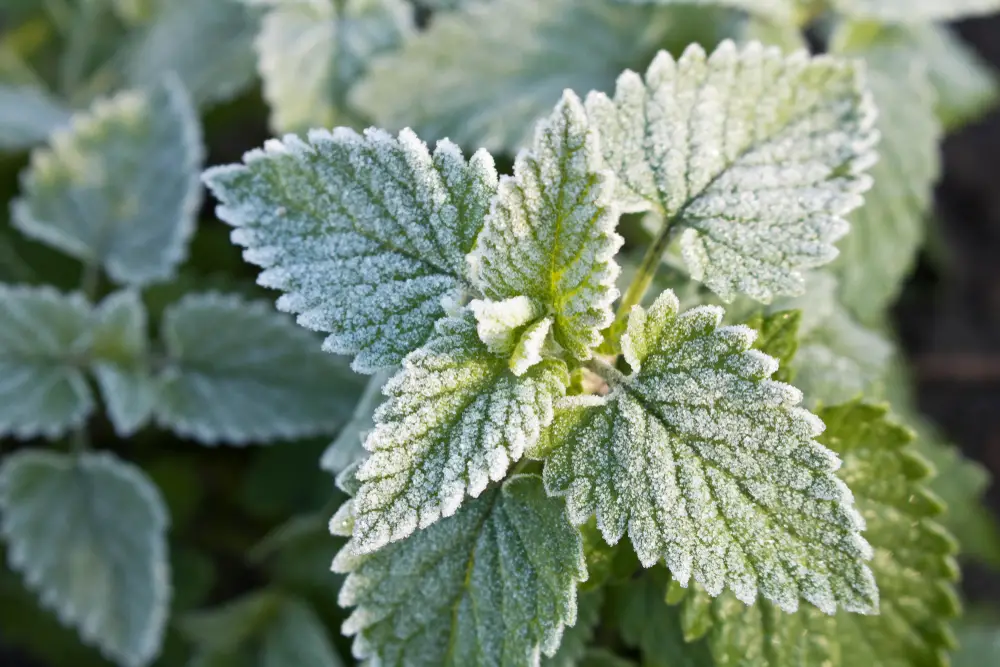
Garden Design To Reduce Risk Of Frost Damage
There are things a gardener can do when designing a garden or deciding where to plant individual specimens to minimize the risk of frost damage.
- Only use plants listed as hardy in your USDA hardiness zone
- Avoid planting low-lying areas more prone to frost formation, or be sure to use only frost hardy plants in these locations
- Avoid planting tender plants at the base of slopes
- Plant frost tender plants against a south-facing wall that will provide some shelter and radiant heat to reduce the risk of frost formation
- Use the placement of brick walls/pathways or large boulders to store heat from the sun during the day, it then slowly releases overnight and offers some frost protection to individual plants
Garden Practices To Avoid Frost Damage
To reduce frost damage to your plants, there are preemptive steps you can take so that frost damage won’t be a concern in the first place.
Wait Until Later In Spring To Plant Transplants
The easiest way to prevent frost damage to young vegetable or flowering annual transplants in the spring is to plant them well after the risk of frost has passed. Planting earlier doesn’t always give you a head start on the growing season if it means your new plants get knocked out by a late frost. Also, some transplant varieties may just sit there and not put on any new growth until the soil and air temperatures warm up enough.
Choose Earlier Maturing Crops
To avoid possible loss of crops like tomatoes to early fall frosts, choose varieties with fewer days to maturity. That way, they’ll ripen long before there’s any risk of frost damage.
Water Plants Before A Frost
Moist soil retains heat better than dry soil, so water your plants before a frost. The water in the soil allows the soil to hold up to 4 times as much heat as dry soil. The temperature at the soil’s surface can be as much as 5 degrees F warmer than dry soil.
Water the plants mid-day before a forecasted overnight frost, so that the moist soil can absorb as much heat from sunlight as possible before sunset.
Watering also increases the humidity around the plants. Here’s just a tiny bit of chemistry (stay with me!): When this moisture in the air condenses on the plants and surrounding soil, heat is produced. This increases the temperature just enough to prevent freezing and protect the plants.
So aim to water well but don’t leave the soil soaking wet or soggy. Too much water in the soil might freeze and damage the roots.
Mulch Newly-Planted Specimens
The soil takes longer to cool down in the winter, so even if a frost hits, the soil temperature won’t go below freezing. A frost may cause newly-planted trees, shrubs, and perennials to go dormant above-ground but their roots will still be active.To keep the soil warm for as long as possible, apply a heavy mulch around them to give them more time to establish a new root system before winter.
How To Protect Plants From Frost
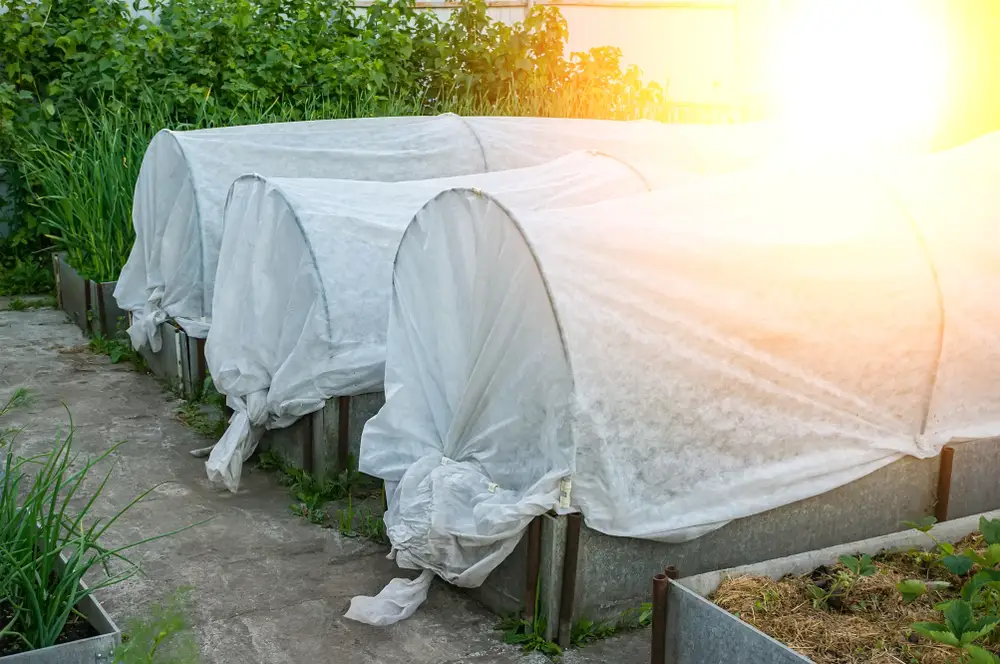
Even if we take steps to design and manage our gardens to minimize the risks of frost damage, unpredictable weather patterns can still require us to take action to protect our garden treasures. There may be times we need to install frost protective coverings over our plants.
Important Considerations When Choosing Coverings
Home gardeners most often cover their plants to protect them from a short-lived overnight frost. Put covers in place for the night and then remove them the following day when warmer temperatures return and the risk of frost has passed. For overnight protection, just about anything can be used to create a protective covering.
However, if the temperatures are forecast to hover at or below freezing for more than a day – making it necessary for frost protection to be left in place for the duration – then gardeners need to be more selective about what coverings they use.
The other consideration in choosing frost protection for your plants, is whether you want to protect individual plants, or cover a larger planted area.
Air Circulation Consideration
Air circulation around plants is an important part of frost protection. Coverings need to allow for good air circulation to prevent the build up of moisture on the foliage.
If you want to leave a frost covering on for a day or more, then your best option is a commercial row cover product. They allow proper air circulation around the plants. These are specifically designed to be left in place for longer-term frost protection. The benefits of these coverings are:
- Sunlight can penetrate the fabric
- They hold in the heat
- They keep out the cold
- Allows air circulation
You can leave commercial row covers on for several days but remove them once air temperature stays above about 50 F (10 C) underneath.Otherwise, plants can overheat (which is just as damaging as frost.) Temperatures underneath a commercial frost blanket can be 30 F (12 C) or warmer than the surrounding air, depending on how sunny the weather is.
If you’re using materials other than the commercially-available products, they can only be used overnight. You’ll need to remove or roll them up during the day to allow for air to circulate.
Light, Moisture, & Heat Tips
Light
Coverings left in place for more than just one night need to allow light to penetrate (plants can’t be kept in the dark!). As we stated above, you also need air circulation to avoid moisture build-up. “Frost blankets” or “floating row cover” are the only materials that meet this criteria.
Moisture
Spray your plants with water. It seems counter-intuitive but wet plants are better able to withstand a light frost. Just another wee bit of chemistry: When water freezes, it releases heat. So when the water on the plants freezes, it actually helps to keep them warm. (I know, it sounds backwards!) Also, the thin layer of ice that forms acts like an insulator to protect the interior of the plant from further cold.
Heat
To add warmth under a cover, there are some easy do-it-yourself methods. Here’s some examples:
Plastic bottles: place plastic milk jugs or soda bottles full of water (with the caps on) beside plants during the day. Do this before installing protective coverings over a row of plants overnight. The water absorbs the sun’s heat during the day and slowly releases it overnight. This helps keep the temperature under the cover warmer.
Rocks: Another option is to use rocks, bricks, or large stones. Place these next to your plants, they absorb and store heat during the days and then release it at night.
Materials To Use To Protect Plants From Frost
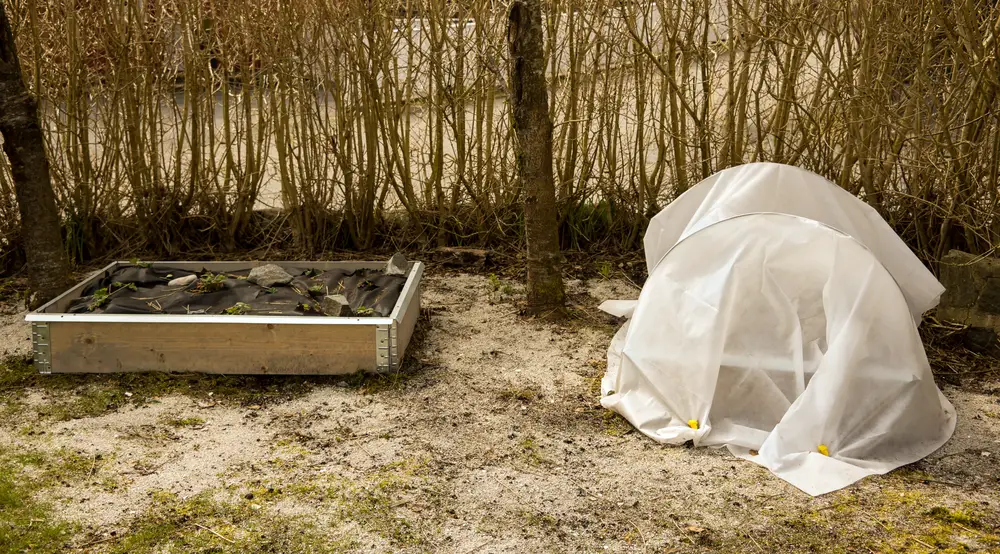
Covering plants with frost protective materials works in two ways.
- They prevent frost (cold air) from settling directly on the plants’ foliage
- Install coverings right down to the soil level so that they trap the radiant heat released from the soil overnight. This keeps the temperature comfortably above freezing around the plants under the cover
For effective overnight covers, it’s important they are put in place late in the day before the sun sets. That way there’ll be no loss of radiant heat before the cover is in place.
Depending on the size of your garden, and the number/type of plants you want to protect, coverings can be installed over individual plants or whole rows/planted areas in a garden.
Frost Blankets
You can use just about any material for frost protection if you intend to use it only overnight and remove it in the morning. It just needs to be something that won’t let the cold air penetrate through.
Some options include:
- Bed sheets
- Large towels
- Table cloths
- Painter’s drop cloths
- Plastic tarp (with caveats)
- Commercial frost blanket or row cover products
- Cardboard boxes
- Cloches
Tarp vs Other Material
You can use any of the above materials to cover plants overnight but plastic tarps (or shower curtains) should be your last choice.
Tarps will work in a pinch but it’s important to know that plastic can transmit cold better than fabrics. This can lead to frost damage on the plant if the tarp comes into contact with it. So, if you have to choose plastic tarp, place it as far away from foliage as possible. Use supports, such as wooden stakes, to keep it off the foliage.
A better choice is the clear plastic sheeting products commonly referred to as “greenhouse plastic” or “greenhouse tarp.” These are specifically designed to protect plants. This plastic has different properties than hardware store plastic tarps. It is usually installed over supportive hoops, and the sides are rolled up a bit during the day to allow proper air flow.
Commercial Row Cover
These commercial frost protection products (e.g. Reemay cloth) are made from spun polypropylene, and come in different weights to offer varying levels of protection. The heavier the weight, the lower temperatures they will provide protection. The lightest weight of these is sometimes referred to as “floating row covers.” Their light weight allows them to rest lightly on the tips of the plants and float over the row without the need of supports and, importantly, without transmitting cold to the plants they rest on.
Protecting Individual Plants From Frost
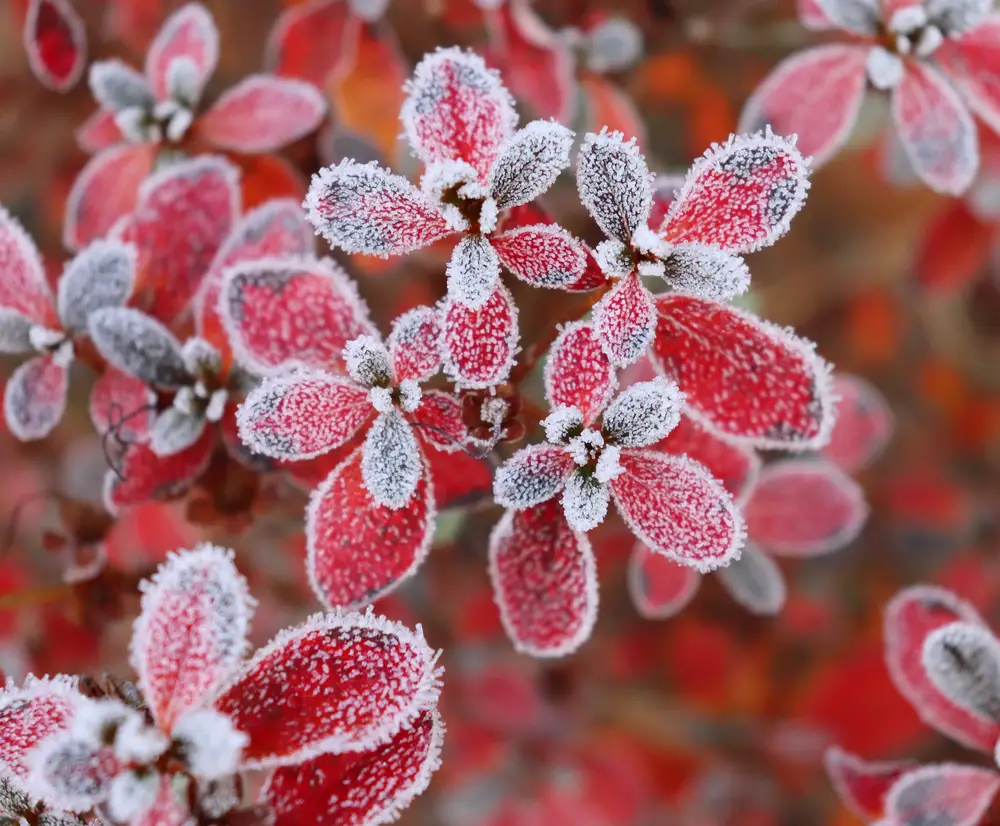
Cardboard Box
In a pinch you can also use cardboard boxes or an overturned plastic bucket to protect individual plants overnight. Place a box or bucket over – not touching – the plant and secure the edges at soil level so there are no gaps for heat to escape. Remove the cover the following morning once the air temperature goes back comfortably above freezing.
Cloche
To protect young transplants in spring, you can cover individual plants with a dome-shaped cover known as a “cloche” (the French word for “bell”). As the name implies, these are bell-shaped covers you place over a plant like a big lid to form a seal at soil level.
You only use a cloche to cover a plant overnight. You remove it the following morning after temperatures rise above freezing. If not removed, a plant may suffocate or get too hot as a result of the day’s heat trapped underneath. It works like a miniature greenhouse.
You can purchase glass cloches commercially in various sizes to accommodate different-sized plants or you can make your own!
How To Make Your Own Cloche
To make your own cloche, cut the bottom off a 4 quart (4 liter) plastic milk jug or 2 quart (2 liter) plastic pop bottle. Leave the cap screwed on to trap in the heat overnight. Place the plastic cover over the plant and push the edges down into the soil so it’s well-anchored in place.
Protecting Rows Or Small Planted Areas
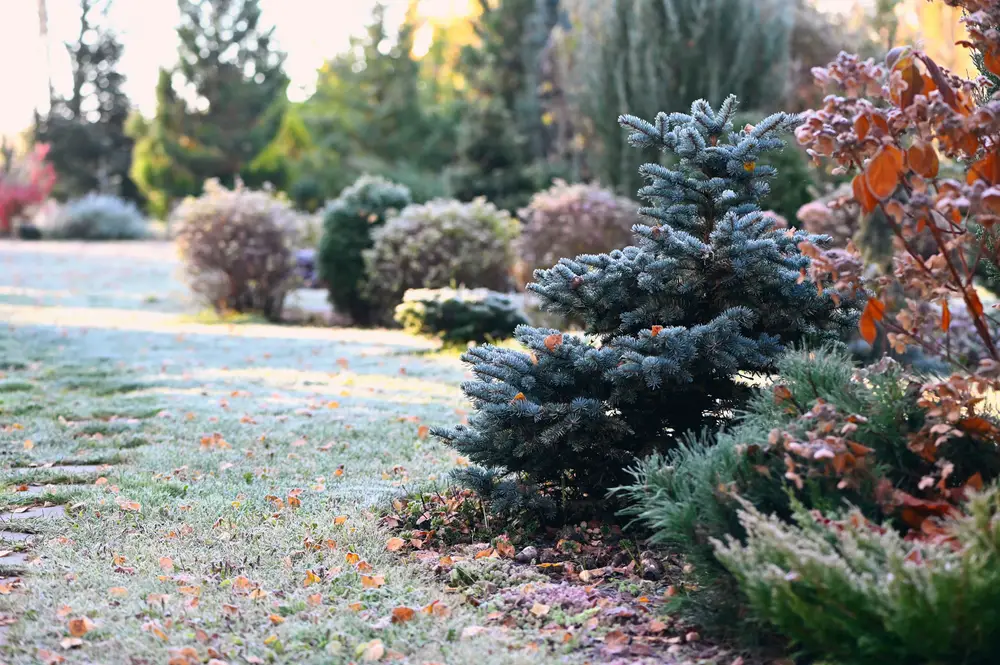
If you decide to cover a whole row or planted area of plants, it’s important that the frost cover is held over – and not touching – the plants. If the material comes in contact with the plants, the cold temperature will pass through the cover and damage any foliage it touches.
So, in addition to choosing a material to cover your plants, you’ll need to create some sort of support to hold it up. You can use wooden stakes, several tall overturned plant pots or buckets, or create hoops using metal or pvc piping.
The only cover material that can safely be used without supports is commercial floating row cover because of its light weight.
How To Install Protective Frost Covers
The following steps apply whether you’re installing a fabric cover over a row or planted area of plants, or covering an individual plant too large for a cloche.
- Set up supportive frames, stakes or other supports to hold the protective covering over – but not touching – the plants.
- Drape the protective cover over the supports so that it covers the plants and reaches all the way down to the soil on all sides.
- Secure the edges of the covering at soil level so that there are no gaps between the edge of the cover and the soil. Use bricks, stones, or pieces of wood to anchor it. Or bury the edges of the cover with soil to create a seal.
- If the cover will only be in place overnight, remove it once the temperatures are safely above freezing the following morning.
Whatever material you choose to use to cover your plants, you need to set up some sort of a frame system to support the cover just above your plants so that it isn’t touching any foliage.
For short planted rows, you can use plastic or metal hoops to arch over the row every few feet. To protect taller plants in the fall, I’ve used bamboo stakes with a little plastic flower pot upside down on the top so the stake doesn’t poke through the row cover fabric.
It’s important to ensure the protective cover drapes down to soil level all around the plant, leaving no gaps, to trap the soil’s radiant heat inside the cover.
Protecting Plants In Containers
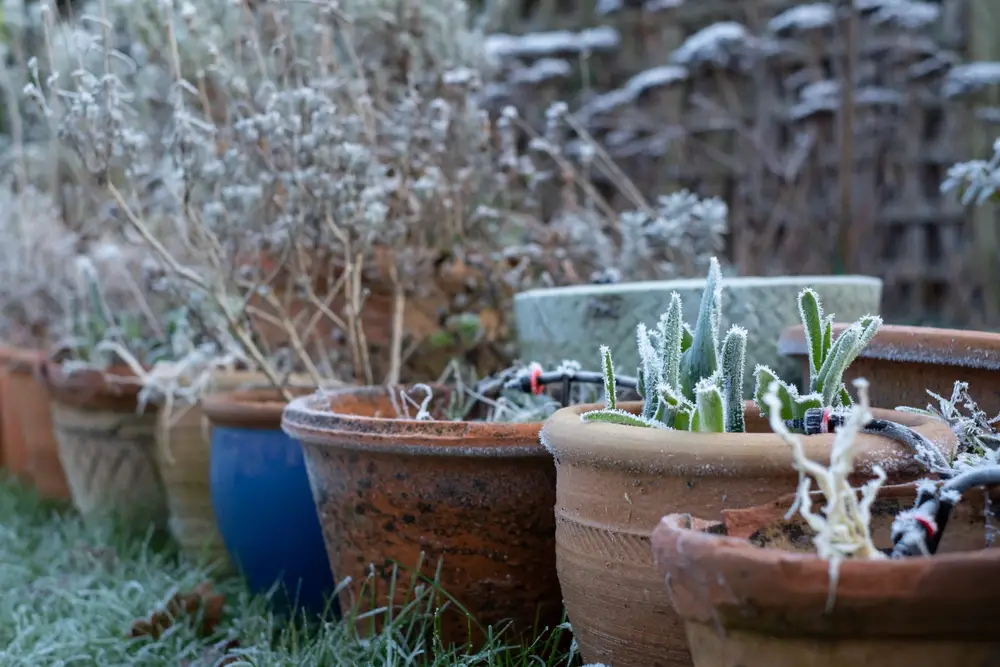
Plants in containers are more sensitive to cold temperatures because their root systems in the pot are above ground. They can be protected from light frost in the same manner as individual plants. Use frost blankets and cover the plants and the container down to the ground.
In the case of heavy and prolonged frosts, however, container plants are at risk of frost damage. If you’re growing perennial plants in containers in USDA hardiness zones that experience hard frosts or extended periods just below freezing, you need to take additional measures to protect them. Here’s some of my top ways:
- Start by moving your containers up against the wall of a building where they will be better protected than out in the open
- Group all your containers close together to minimize the available spaces for cold air to settle
- You can then cover the whole grouping with a large protective covering as you would a planted area in your garden
- If any of the containers are small enough to bring inside, such as hanging baskets of flowering annuals, then do that overnight
- Larger containers could be placed by a window inside an unheated garage
Another resourceful way to protect large containers is using strings of incandescent Christmas lights!
Incandescent Christmas Lights
Good old fashioned string Christmas lights – those we used before the arrival of LED’s – can be used to protect plants from frost. Incandescent bulbs give off heat (which is in part what makes them so energy inefficient as a light source!) Enough heat, in fact, that during a frost they can keep the immediately-surrounding air temperature just above freezing, especially when they’re used in conjunction with frost blankets. If you’ve ever lived in a region that gets snow at Christmas, you’ll remember those nights when Christmas lights would form little glowing hollows of color under the snow!
Also, incandescent string lights can be hung on shrubs or small trees to help ward off light frosts. I used this strategy when I grew a Myer lemon in hardiness zone 8a, which is prone to occasional temperatures just below freezing. The tree was growing under a wide overhang against a south-facing wall. I strung Christmas lights throughout the lemon tree to provide a little heat when needed. It was enough heat to prevent any damage to the tree’s foliage and fruit.
I’ve also wrapped strings of incandescent lights around large containers planted with hardy evergreens to prevent the soil from freezing.
FAQ
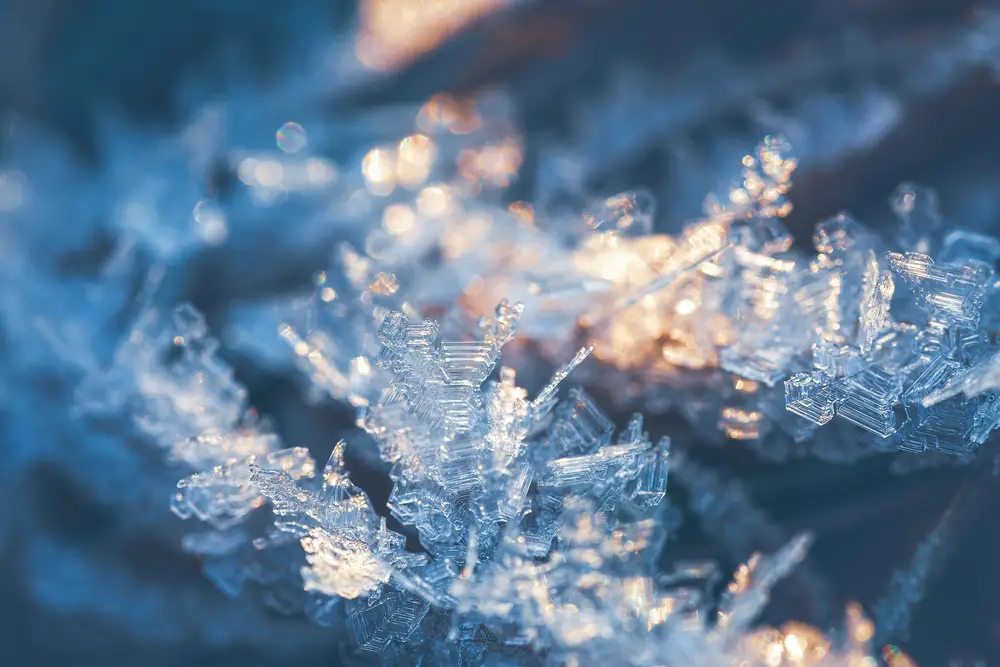
Q: Will Cardboard Boxes Protect Plants From Frost?
A: Yes, you can use them to protect individual plants overnight. But you need to remove them the following morning once the air temperature is above freezing.
Q: Will A Tarp Protect Plants From Frost?
A: Yes, you can use them but you must ensure that they do not touch the plants. Plastic transmits cold more than other materials. If you are going to use a tarp, create some sort of support to hold it up. You can use wooden stakes, several tall overturned plant pots or buckets, or create hoops using metal or pvc piping.
Q: How To Cover Plants To Protect From Frost?
A: Whatever material you choose to cover your plants, be sure it doesn’t come in contact with the plants. Use metal hoops or wooden stakes to hold it up. Also make sure the material goes right down to the soil all around the plant. Anchor the material to the ground with bricks or long pieces of lumber, or bury the edges with soil. It’s important there are no gaps for heat to escape from inside the cover.
Q: What Covers To Protect Plants From Frost Are The Most Effective?
A: You can use anything to cover plants overnight if you plan to remove the covering the next morning. The material needs to be a tight weave so that cold air can’t pass through it and so that heat will get trapped underneath it.
If you need to leave the covering on for several days, the only option is a commercial row cover product made of spun polypropylene. This material lets light through, keeps the cold out and the heat in, and allows for good air circulation around the plants so there’s no build-up of moisture under the cover.
Q: How To Protect Plants From Freezing Weather?
It’s important to know that freezing weather is different from frost and the difference is a matter of just a few degrees. Frosts occur when the temperatures drop down to 36 – 28 F (2 to -2 C) – just above or below freezing – and are short-lived. Freezing weather comes with sustained temperatures below 28 F (-2 C) and generally lasts for the rest of the winter season. To get plants ready for winter’s freezing temperatures involves more than just coverings.

